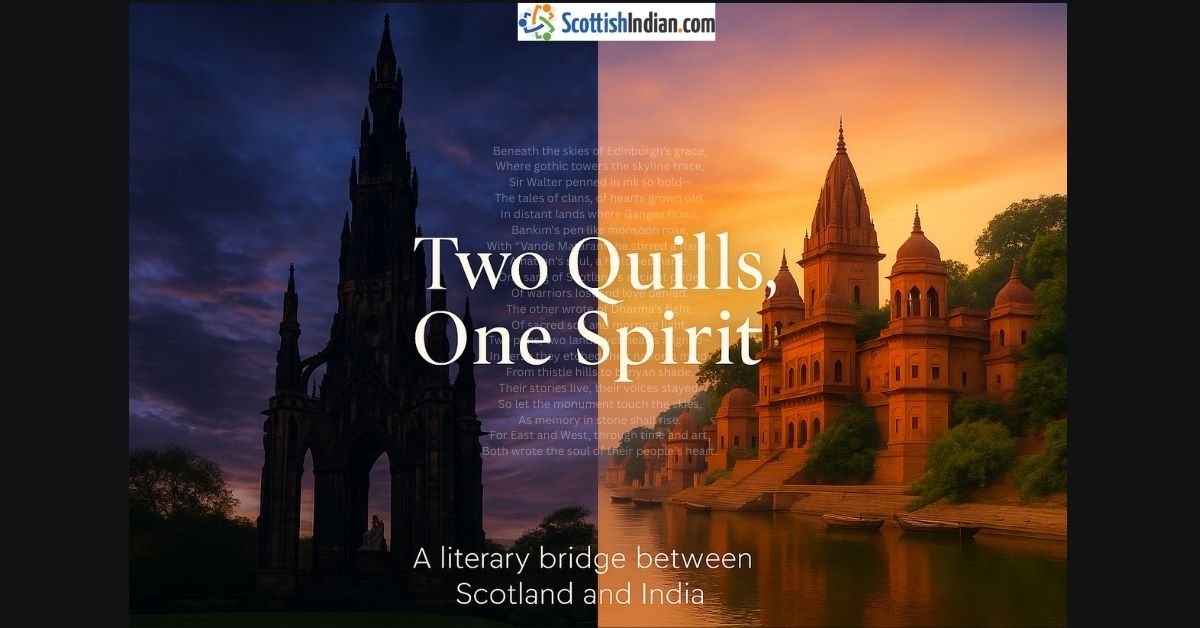Beneath the soaring spire of the Scott Monument in Edinburgh, one reflects on the enduring power of storytelling. Especially when considering the literary legacy of Sir Walter Scott and Bankim Chandra—two voices separated by continents but united in purpose.
🖋️ Two Quills Across Continents
Sir Walter Scott, immortalized in stone beneath the gothic arches, was more than a novelist. He was the voice of a nation, shaping Scotland’s soul through verse and fiction.
Thousands of miles away, in a land equally steeped in history and complexity, another quill was at work—Bankim Chandra Chattopadhyay.
Though they never met, and though they wrote in different languages and times, Scott and Bankim Chandra shared something powerful. They both believed literature could shape a nation. Their pens were swords. Their ink, a balm and a beacon.
For instance, Scott’s works, from Waverley to Ivanhoe, romanticized Scotland’s past. He brought Highlanders, heroes, and haunting landscapes to life. He built national pride not through manifestos but through stories. By blending folklore, myth, and memory, he gave Scotland a voice in an age of cultural suppression.
Similarly, Bankim Chandra—often called the father of the Indian novel—carried a torch for India’s identity. With Anandamath and the song “Vande Mataram,” he ignited Indian nationalism through fiction. His stories mixed history with spiritual and moral questions. He gave readers not just stories, but purpose and unity under colonial rule.
Their similarities are striking. Both drew inspiration from their land. Both used narrative to protect cultural identity. And both showed that words, when used with heart and conviction, can move people more than any speech or weapon.
The impact of Sir Walter Scott and Bankim Chandra goes beyond their era. Their words remain timeless.
As I stood before the Scott Monument, I thought of Bankim Chandra. I felt the invisible thread between them—a literary kinship that defied geography. Scott carved Scotland into legend. Bankim sang India into being.
In fact, their legacy lives beyond books and statues. It lives in the spirit of two nations shaped by stories and imagination.
✍️ Poetic Tribute: Two Quills, One Spirit
Beneath the skies of Edinburgh’s grace,
Where gothic towers the skyline trace,
Sir Walter penned in ink so bold—
The tales of clans, of hearts grown old.
In distant lands where Ganges flows,
Bankim’s pen like monsoon rose,
With “Vande Mataram” he stirred a flame,
A nation’s soul, a hallowed name.
One sang of Scotland’s ancient pride,
Of warriors lost and love denied.
The other wrote of Dharma’s fight,
Of sacred soil and morning light.
Two pens, two lands, yet hearts aligned—
In verse they etched their nation’s mind.
From thistle hills to banyan shade,
Their stories live, their voices stayed.
So let the monument touch the skies,
As memory in stone shall rise.
For East and West, through time and art,
Both wrote the soul of their people’s heart.
The stories of Sir Walter Scott and Bankim Chandra Chattopadhyay remind us that culture and imagination know no borders. At ScottishIndian.com, we celebrate the vibrant threads that connect Scotland and India—through art, literature, music, and everyday moments.
👉 Explore more cultural connections in our Blogs or join the conversation in our Whatsapp Community.






